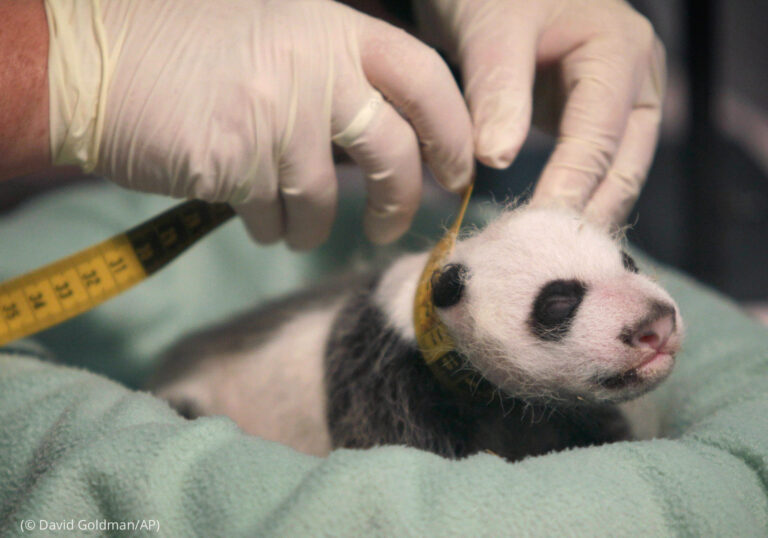Newborn giant pandas are no larger than a stick of butter.
That pandas are born so fragile is one of the factors that led U.S. scientists to study panda biology to better protect the majestic species, which can grow into 115-kilogram adults. The exact length of panda pregnancies has also confounded researchers.
But with ultrasound technology, Dr. Sam Rivera and his team at Zoo Atlanta tracked panda development in utero — when cubs were the size of a grain of rice — to better understand gestation and more accurately predict births. The pregnancies belonged to Lun Lun, one of Zoo Atlanta’s four pandas on loan from China.
“We’re able to monitor the development of those embryos and share that experience with our Chinese colleagues,” Rivera said.
“That’s been one of our greatest experiences of being able to use these techniques to help with a captive reproduction.” Since her arrival at Zoo Atlanta in 1999, Lun Lun has birthed seven cubs.
Her stay at the zoo is part of a long-standing partnership between zoos and institutions in the U.S. and the China Wildlife Conservation Association that has provided opportunities to advance panda research, while also supporting conservation efforts in pandas’ natural habitat in China. Once listed as endangered, giant pandas in the wild increased from 1,000 in the mid-1990s to 1,800 in 2014, when researchers in the People’s Republic of China last surveyed the population.
“It’s one of those great conservation success stories,” Rivera said. While Lun Lun and Zoo Atlanta’s other pandas will return to China in November, the cooperation will continue.
On May 29, the Smithsonian Institution announced that its National Zoo and Conservation Biology Institute in Washington will receive two pandas from China, Bao Li and Qing Bao, before the end of 2024. One of those pandas, 2-year-old Bao Li, is the son of Bao Bao, who was born at the National Zoo in 2013.
Bao Li’s grandparents, Tian Tian and Mei Xiang, lived at the zoo in Washington from 2000 to 2023. Zoo Atlanta, the San Diego Zoo and the San Francisco Zoo are also in talks to host pandas from China as soon as next year.
Giant pandas are among the biggest attractions at U.S. zoos. The National Zoo’s Giant Panda Cam received more than 100 million page views between its launch in 2000 and the return of the National Zoo’s giant pandas to China in November 2023.
“There’s no way not to fall in love with the pandas,” Rivera says. “The way they act when they’re eating bamboo is so endearing to the public.”
The U.S.-China conservation cooperation provides far more than opportunities to adore cute cubs and clumsy adults known for their signature black-and-white fur. Illegal poaching and habitat destruction drove giant pandas to endangered status in their native habitat in the mountains of China.
Conservation efforts have since lifted the species to vulnerable status. Those include the PRC government’s 1998 ban on logging in panda habitat and the subsequent establishment of nature reserves in the country where pandas can thrive undisturbed.
U.S.-China cooperation on giant pandas began in 1972. During President Richard Nixon’s state visit to Beijing, first lady Pat Nixon mentioned her fondness for giant pandas to Chinese Premier Zhou Enlai.
As a gesture of goodwill, Zhou gifted two giant pandas to the American people. Since Mrs. Nixon welcomed the first pair of bears to the National Zoo, the Smithsonian and Chinese colleagues have collaborated for more than 52-years, making groundbreaking advances in understanding giant pandas’ biology, behaviour, breeding, reproduction, health and habitat.
In addition to improving understanding of panda gestation, Rivera said, Zoo Atlanta has provided $17 million for panda conservation in China over 25 years. The funding aids panda conservation at eight different nature reserves across China, supporting everything from research into panda health to reforesting habitat, Rivera said.
According to the Smithsonian, U.S. ecologists, starting in 2001, trained 50 staff members at China’s Wolong Nature Reserve to use geographic information systems in wildlife management. By 2014, U.S. ecologists had trained more than 1,000 staff members, students and ecology professionals in China on wildlife survey techniques.
During a November 2023 visit to the U.S., People’s Republic of China President Xi Jinping called giant pandas “envoys of friendship between the Chinese and American peoples.” He added: “We are ready to continue our cooperation with the United States on panda conservation.”
Brandie Smith, the John and Adrienne Mars director of the Smithsonian’s National Zoo, said the Smithsonian is also looking forward to hosting more pandas from China. “Through this partnership, we have grown the panda population, advanced our shared understanding of how to care for this beloved bear and learned what’s needed to protect wild pandas and preserve native habitat,” she said.











